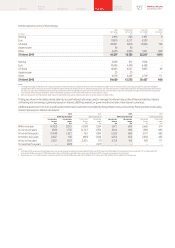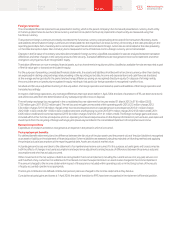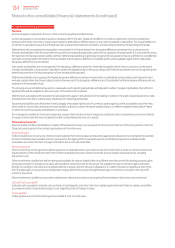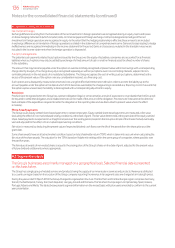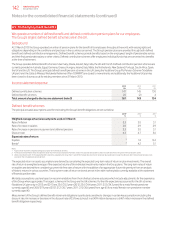Vodafone 2013 Annual Report Download - page 134
Download and view the complete annual report
Please find page 134 of the 2013 Vodafone annual report below. You can navigate through the pages in the report by either clicking on the pages listed below, or by using the keyword search tool below to find specific information within the annual report.
A1. Signicant accounting policies (continued)
Revenue
Revenue is recognised to the extent the Group has delivered goods or rendered services under an agreement, the amount of revenue can be measured
reliably and it is probable that the economic benets associated with the transaction will ow to the Group. Revenue is measured at the fair value
of the consideration received, exclusive of sales taxes and discounts.
The Group principally obtains revenue from providing the following telecommunication services: access charges, airtime usage, messaging,
interconnect fees, data services and information provision, connection fees and equipment sales. Products and services may be sold separately
or in bundled packages.
Revenue for access charges, airtime usage and messaging by contract customers is recognised as services are performed, with unbilled revenue
resulting from services already provided accrued at the end of each period and unearned revenue from services to be provided in future periods
deferred. Revenue from the sale of prepaid credit is deferred until such time as the customer uses the airtime, or the credit expires.
Revenue from interconnect fees is recognised at the time the services are performed.
Revenue from data services and information provision is recognised when the Group has performed the related service and, depending on the
nature of the service, is recognised either at the gross amount billed to the customer or the amount receivable by the Group as commission for
facilitating the service.
Customer connection revenue is recognised together with the related equipment revenue to the extent that the aggregate equipment and
connection revenue does not exceed the fair value of the equipment delivered to the customer. Any customer connection revenue not recognised
together with related equipment revenue is deferred and recognised over the period in which services are expected to be provided to the customer.
Revenue for device sales is recognised when the device is delivered to the end customer and the sale is considered complete. For device sales made
to intermediaries, revenue is recognised if the signicant risks associated with the device are transferred to the intermediary and the intermediary
has no general right of return. If the signicant risks are not transferred, revenue recognition is deferred until sale of the device to an end customer
by the intermediary or the expiry of the right of return.
In revenue arrangements including more than one deliverable, the arrangements are divided into separate units of accounting. Deliverables are
considered separate units of accounting if the following two conditions are met: (1) the deliverable has value to the customer on a stand-alone basis
and (2) there is evidence of the fair value of the item. The arrangement consideration is allocated to each separate unit of accounting based on its
relative fair value.
Commissions
Intermediaries are given cash incentives by the Group to connect new customers and upgrade existing customers.
For intermediaries who do not purchase products and services from the Group, such cash incentives are accounted for as an expense. Such cash
incentives to other intermediaries are also accounted for as an expense if:
a the Group receives an identiable benet in exchange for the cash incentive that is separable from sales transactions to that intermediary; and
a the Group can reliably estimate the fair value of that benet.
Cash incentives that do not meet these criteria are recognised as a reduction of the related revenue.
Inventory
Inventory is stated at the lower of cost and net realisable value. Cost is determined on the basis of weighted average costs and comprises direct
materials and, where applicable, direct labour costs and those overheads that have been incurred in bringing the inventories to their present location
and condition.
Leasing
Leases are classied as nance leases whenever the terms of the lease transfer substantially all the risks and rewards of ownership of the asset to the
lessee. All other leases are classied as operating leases.
Assets held under nance leases are recognised as assets of the Group at their fair value at the inception of the lease or, if lower, at the present value
of the minimum lease payments as determined at the inception of the lease. The corresponding liability to the lessor is included in the statement
of nancial position as a nance lease obligation. Lease payments are apportioned between nance charges and reduction of the lease obligation
so as to achieve a constant rate of interest on the remaining balance of the liability. Finance charges are recognised in the income statement.
Rentals payable under operating leases are charged to the income statement on a straight-line basis over the term of the relevant lease.
Benetsreceived and receivable as an incentive to enter into an operating lease are also spread on a straight-line basis over the lease term.
Notes to the consolidated nancial statements (continued)
132 Vodafone Group Plc
Annual Report 2013







